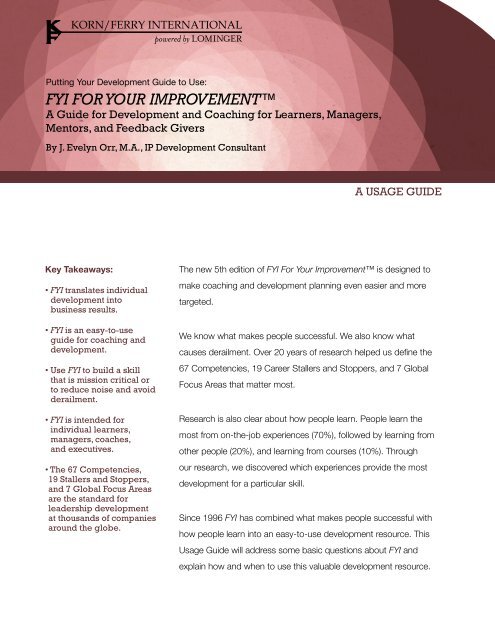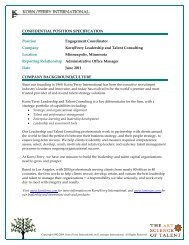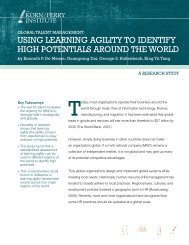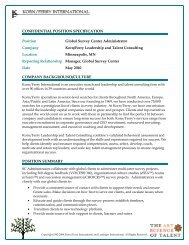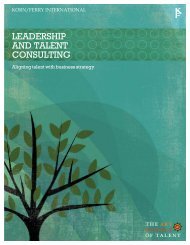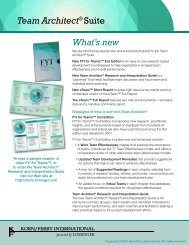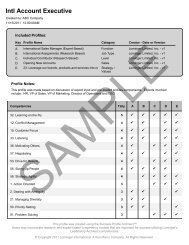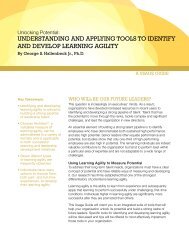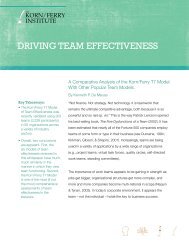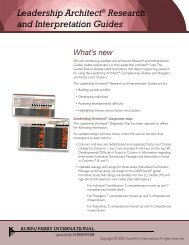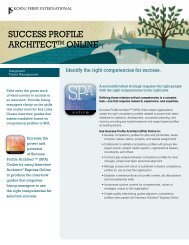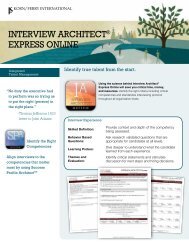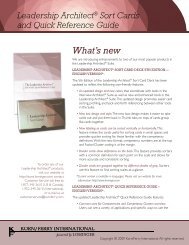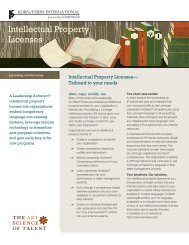FYI For Your Improvement⢠- Lominger
FYI For Your Improvement⢠- Lominger
FYI For Your Improvement⢠- Lominger
Create successful ePaper yourself
Turn your PDF publications into a flip-book with our unique Google optimized e-Paper software.
Putting <strong>Your</strong> Development Guide to Use:<strong>FYI</strong> <strong>For</strong> <strong>Your</strong> ImprovementA Guide for Development and Coaching for Learners, Managers,Mentors, and Feedback GiversBy J. Evelyn Orr, M.A., IP Development ConsultantA usage guideKey Takeaways:• <strong>FYI</strong> translates individualdevelopment intobusiness results.• <strong>FYI</strong> is an easy-to-useguide for coaching anddevelopment.• Use <strong>FYI</strong> to build a skillthat is mission critical orto reduce noise and avoidderailment.• <strong>FYI</strong> is intended forindividual learners,managers, coaches,and executives.• The 67 Competencies,19 Stallers and Stoppers,and 7 Global Focus Areasare the standard forleadership developmentat thousands of companiesaround the globe.The new 5th edition of <strong>FYI</strong> <strong>For</strong> <strong>Your</strong> Improvement is designed tomake coaching and development planning even easier and moretargeted.We know what makes people successful. We also know whatcauses derailment. Over 20 years of research helped us define the67 Competencies, 19 Career Stallers and Stoppers, and 7 GlobalFocus Areas that matter most.Research is also clear about how people learn. People learn themost from on-the-job experiences (70%), followed by learning fromother people (20%), and learning from courses (10%). Throughour research, we discovered which experiences provide the mostdevelopment for a particular skill.Since 1996 <strong>FYI</strong> has combined what makes people successful withhow people learn into an easy-to-use development resource. ThisUsage Guide will address some basic questions about <strong>FYI</strong> andexplain how and when to use this valuable development resource.
<strong>FYI</strong> provides a commonset of characteristicsrequired for successand facilitates thedevelopment anddeployment of resources,enterprise-wide.Who is <strong>FYI</strong> for?<strong>FYI</strong> is designed for any motivated person with a need and to serve asa guide for managers, mentors, coaches, and feedback givers. It isintended for all levels of an organization.Individual learners who want to take initiative and beproactive about their development. They find that <strong>FYI</strong> is a howtodevelopment guide for a do-it-yourself approach.Coaches and managers working with individual employeesto build skill or avoid derailment. They use <strong>FYI</strong> to find theinformation and tools they need to provide coaching and createa targeted development plan.Executives responsible for talent management and humanresource management. They use <strong>FYI</strong> as a resource to sustainleadership development efforts. <strong>FYI</strong> provides a common setof characteristics required for success and facilitates thedevelopment and deployment of resources, enterprise-wide.What is <strong>FYI</strong>?<strong>FYI</strong> is an entire library in one book. Each chapter is dedicated toa competency, staller/stopper, or global focus area found in theLeadership Architect ® Library. In each chapter you will find detaileddefinitions and descriptions, possible causes, as well as suggestedremedies, on-the-job tasks, and readings that promote development.Competencies are defined as “a measurable characteristic of a personthat is related to success at work. It may be a behavioral skill, a technicalskill, an attribute (such as intelligence), or an attitude (such as optimism)”(The Leadership Machine, p. 5). The Leadership Architect ® Librarycontains a total of 67 Competencies.<strong>FYI</strong> is the entireLeadership Architect ®Library in one book.Career Stallers and Stoppers are the negative characteristics or flameoutfactors that can derail a person’s career. In many respects, theyrepresent the flip side of competencies. The Leadership Architect ®Library contains a total of 19 specific Career Stallers and Stoppers.The Global Focus Areas are the additional characteristics required forglobal business leaders. The Leadership Architect ® Library contains atotal of 7 Global Focus Areas.2
What will I find in each <strong>FYI</strong> chapter?Competency name and number as well as factor and clusterinformation to show where it fits in the Leadership Architect ®Library.Unskilled definitions provide a list of detailed behaviors thatshow what “unskilled” looks like for a competency. Read these tosee if you may be unskilled at a competency. Which bullet pointsdescribe you the best? This is your “before” picture.Global Focus Area name andnumber as well as competencyequivalents that are related.Quote – Read the quotes forinspiration and to give yourself foodfor thought.Substitutes – Under the unskilled definition, there are otherskills that could substitute for the lack of skill in this area. Oneor more of those substitute skills (if you are high in them) canneutralize the negative effects of a lack of the skill. Use thesein your development plan to address an unskilled competency.(Competencies only)Skilled definitions provide a list of detailed behaviors that showwhat “skilled” looks like for a competency. Compare yourself tothe skilled definition. What would you like to be able to do whenyou’re done working on this need? This is your “after” picture.Overused Skill definitions provide a list of detailed behaviorsthat show what “overused” looks like for a competency. Referto these to determine whether you might be overusing one ofyour strengths.Compensators – Under the overused skill definition, thereare a number of compensator skills. If you are high on oneor more of those skills, you can use them to neutralize thenegative effects of overusing one of your strengths. Use thesein your development plan to address an overused competency.(Competencies and Global Focus Areas only)Some Causes – We list numerous reasons why you might havethis need. Use these to specify what your need looks like exactly.Check the causes that might apply to you. Many developmentalefforts have floundered because the plan attacked the wrongproblem. Write down your particular need—what it looks like,what causes it, whom it plays out with and in what situations. Ifyour causes aren’t listed, add them to the list.Factors and Clusters – Allcompetencies and career stallersfall into one of 8 Factors and26 Clusters. This means thata competency (or staller) in aparticular cluster is somewhatsimilar to the others in that cluster.You may want to check foradditional tips within the cluster(and perhaps the factor) for eachcompetency. (Competencies andStallers and Stoppers only)3
The Map – The map gives you the lay of the land. It reviews the generalcase for the competency, how it operates, and why it’s important. Especiallyimportant to remember are things about the competency you didn’tunderstand before you read the map. Those added learnings will make adifference in your development plan.Some Remedies were developed from research findings—whatexperiences teach them, what they look like, what their elements are.Based on our research and experience, these are the tips that are mostlikely to work. We kept these tips brief, doable, and action oriented. Tenor more tips are included to work directly on this need. Although a fewmay be longer-term, most are things you can start working on today. Wewanted to give motivated people a way to get started right away and seeresults quickly. Remedy titles are written as diagnostic questions and actionstatements so you can easily identify and choose one or two to include inyour development plan.Suggested Readings wereselected from expert reviews,best-seller lists, and reputablepublishers based on their relevance,global perspective, and ROI. Weselected readings that were current,available, organized well, and full ofsuggestions and examples. Plentyfor you to choose from!Develop-in-Place Assignments are job tasks that require application ofcertain competencies. Research shows that 70% of development happenson the job, and jobs differ in development power and in the competenciesthey address. You can’t always change jobs for development reasonsalone, but there is almost always a develop-in-place assignment that youcan select in your current job to address your development need.Staller and Stopper name and number as well as factor and clusterinformation showing where it fits in the Leadership Architect ® Library.A Problem lists statements to describe detailed behaviors that illustratewhat a staller/stopper looks like when it is “a problem.” Read these to see ifa staller/stopper might be an issue for you.Not a Problem lists statements to describe detailed behaviors thatillustrate what a staller/stopper looks like when it is “not a problem.”Read these to see if a staller/stopper is not a concern for you.Other Causes – A staller results from many sources—what you underdo(unskilled), such as Interpersonal Savvy (31) and what you overdo(overused), such as Drive for Results (53) or Command Skills (9). Reviewthe list to see if any of the unskilled or overused competencies match yourprofile. Use this information to help you decide what to focus on in yourdevelopment plan.4
What additional resources will I find in <strong>FYI</strong>?Content we’ve included in the appendices make it easier for you toidentify the right needs to work on and create an effective developmentplan.Competency Connections in Appendix A highlight how a developmentneed or a career goal may be comprised of a few key competencies.Use this resource when you think your development needs might be acombination of competencies.A development needmay be a combination ofseveral competencies.A Developmental Difficulty Matrix in Appendix B shows on a 5-pointscale how difficult it would be for a typical professional person to developany of the 67 Competencies. It also shows the average skill rating ofthe average population for each competency. This information lets youknow what you’re up against so you can adjust your development plan,remedies, and time line accordingly.The Development Plan in Appendix C has a new format which allowsyou to organize your plan on an easy-to-use two-page spread. Threeexamples illustrate ways to maximize the plan’s effectiveness when youare addressing unskilled, overused, or staller/stopper development needs.An Index has been added to make this edition as user-friendly aspossible and to help you quickly find and address development needsand create your development plan.When do I use <strong>FYI</strong>?There are two primary reasons you would take the <strong>FYI</strong> off your shelf (as acoach or a learner).1. You need to build a skill that is critically important.Maybe you are average at something and you need to bestronger for continued success in your job. Or, you are weak inan area and you want to get better. It might be that you haven’thad experience using a skill but you know it’s important andyou want to try it. Or, you plan to make a change in your job orcareer which will require a different set of skills.Use <strong>FYI</strong> when you needto build a skill that ismission critical or toreduce noise and avoidderailing.2. You need to reduce noise and avoid derailing. Maybe youoveruse a strength and you’re getting negative feedback. Or,you have a staller/stopper that is creating serious problems.5
How do I use <strong>FYI</strong> to build a skill?Lisa has trouble keeping the leadership team’s attentionwhen she’s making presentations. She wants to getbetter, so she takes the <strong>FYI</strong> book off her shelf andbegins to explore the need and create an action plan.Explore the need1 Look in the Index to find an entry that relates to yourneed. Lisa looks up “presentations” and “presentationskills.” She decides to review the whole chapteron Presentation Skills.2 Read through the Skilled and Unskilleddefinitions to figure out what describes your“before” and “after” picture. Lisa realizes that she“may always present the same way, not adjustingto audiences” and she wants to “be effective in avariety of presentation settings.”Create an action plan5 Read through Appendix C: Creating a DevelopmentPlan. Find the My Development Need page to jotnotes. Lisa makes a photocopy of My DevelopmentNeed so she can draft a development plan.6 Check Appendix B: Developmental DifficultyMatrix to see how difficult the competency is todevelop before you commit to the “to be completedby” date on My Development Need. PresentationSkills is moderately difficult to develop. Lisa givesherself six months to develop the skill.563 Review Some Causes to understand why you mighthave this need. Lisa thinks maybe it’s because shegets nervous and is a flat presenter.4 Read through the Map to understand more aboutwhy the competency is so important. The map helpsLisa understand how important it is to be sensitiveto the audience.17 Read the diagnostic questions to see which Remediesapply directly to your need. When a questionresonates, read the action statement and suggestedremedy. Choose a couple to add to your action plan.Lisa decides that remedy 49.3 “Not connecting? Readthe audience.” will help her address the need.278 Select a Develop-in-Place Assignment that canhelp you learn through on-the-job experience. Lisachooses the develop-in-place task “present thestrategy of my unit to others not familiar with mybusiness” as part of her action plan.64391089 Look at the Quotes at the beginning and end of thechapter and choose one that inspires you. Lisachooses Mark Twain’s quote and adds it to her MyDevelopment Need page.10 Scan the list of Suggested Readings. Choose oneor two that you could benefit from reading. Lisawants to read The Exceptional Presenter: AProven <strong>For</strong>mula to Open Up and Own the Room,by T. J. Koegel. She thinks it could help herovercome her nervousness.
How do I use <strong>FYI</strong> to reduce noise andavoid derailment?John is director of supply chain at a large retailer. Johnhas received complaints from several employees that oneof his direct reports, David, is not effectively managing histeam. John wants to get to the bottom of this, so he pullshis <strong>FYI</strong> off the shelf and begins to explore the need.Explore the need1 Scan the Table of Contents to see what might becausing the problem. John reviews the Table ofContents and thinks that David’s issue might beOvermanaging.2 Find the chapter by turning to the page numberlisted. John turns to Chapter 117 - Overmanaging.3 Read through the Problem and Not a Problemdefinitions to figure out whether this staller/stoppermight be what’s causing noise. John sees that theProblem description (i.e., doesn’t empower others,does too much of the work himself/herself) is similarto the feedback he was receiving regarding David. Hesees that the Not a Problem statements like“delegates and empowers” and “works to do lesspersonally and trust others more” will be good goalsfor David. He decides to bring David in for aconversation and action planning session.12Create an action plan4 In Appendix C: Creating a Development Plan,find the My Development Need page to jot notesalong the way. John makes a photocopy of MyDevelopment Need so he can draft a developmentplan with David. They discuss the feedback andbegin to tackle the issue.5 Review Some Causes to understand why you mighthave this need. David thinks that he’s too actionoriented and knows too much about the work andthat these things are contributing to the problem.6 Review the list of Other Causes to see whichcompetencies you might have too much or too littleof that could be causing the staller/stopper. Toimprove Developing Direct Reports, David adds actionsteps from Chapter 19 to his development plan.7 Read through the Map to understand more aboutwhy the competency is so important. David realizesthat by doing other people’s work, he is takinghimself away from other priorities.8 Select a Develop-in-Place Assignment that canhelp you learn through on-the-job experience. Davidchooses to “manage something remote away frommy location” for on-the-job development.9 Scan the list of Suggested Readings. Choose oneor two that you think you could benefit from reading.David decides to read What to Do When YouBecome the Boss, by B. Selden.10 Complete the My Development Need page andcommit to a “to be completed by” date. John andDavid complete the My Development Need pageand commit to check progress on a regular basis.374 1058697
A versatile resource for enhancingleadership development<strong>FYI</strong> <strong>For</strong> <strong>Your</strong> Improvement is designed to make coaching anddevelopment planning easy and targeted. <strong>FYI</strong> is intended to be used byindividuals and organizations to enhance development.• An individual who is proactive can use this development resourceto assess needs and continuously improve.• A manager or a coach can take <strong>FYI</strong> off the shelf anytime there isa development need that is critically important for success.To find out moreabout <strong>FYI</strong> <strong>For</strong> <strong>Your</strong>Improvement 5 th Edition,visit www.lominger.com.• An executive in charge of talent management or leadershipdevelopment for an organization can embed <strong>FYI</strong> into any programthat seeks to improve employees’ skills in mission-critical areas.<strong>FYI</strong> is an easy-to-use reference that has become the standard for leadershipdevelopment at thousands of companies around the globe. How will youuse <strong>FYI</strong>?J. Evelyn Orr, M.A. is Intellectual Property DevelopmentConsultant with Korn/Ferry International Leadership andTalent Consulting.About Korn/Ferry InternationalKorn/Ferry International (NYSE:KFY), with more than 90 offices in 40countries, is a premier global provider of talent management solutions.Based in Los Angeles, the firm delivers an array of solutions that help clientsto identify, deploy, develop, retain and reward their talent.About <strong>Lominger</strong>Founded in 1991 by Robert W. Eichinger, Ph.D. and Michael M. Lombardo,Ed.D., <strong>Lominger</strong> produces a suite of competency-based leadershipdevelopment resources for individuals, teams, and organizations. In August2006, <strong>Lominger</strong> joined the Korn/Ferry International family of companies.<strong>For</strong> more information on the Korn/Ferry International family of companies,visit www.kornferry.com.8


